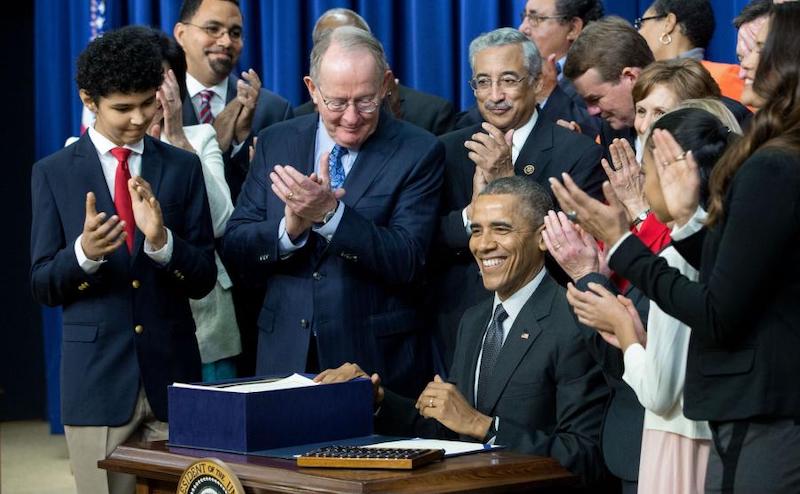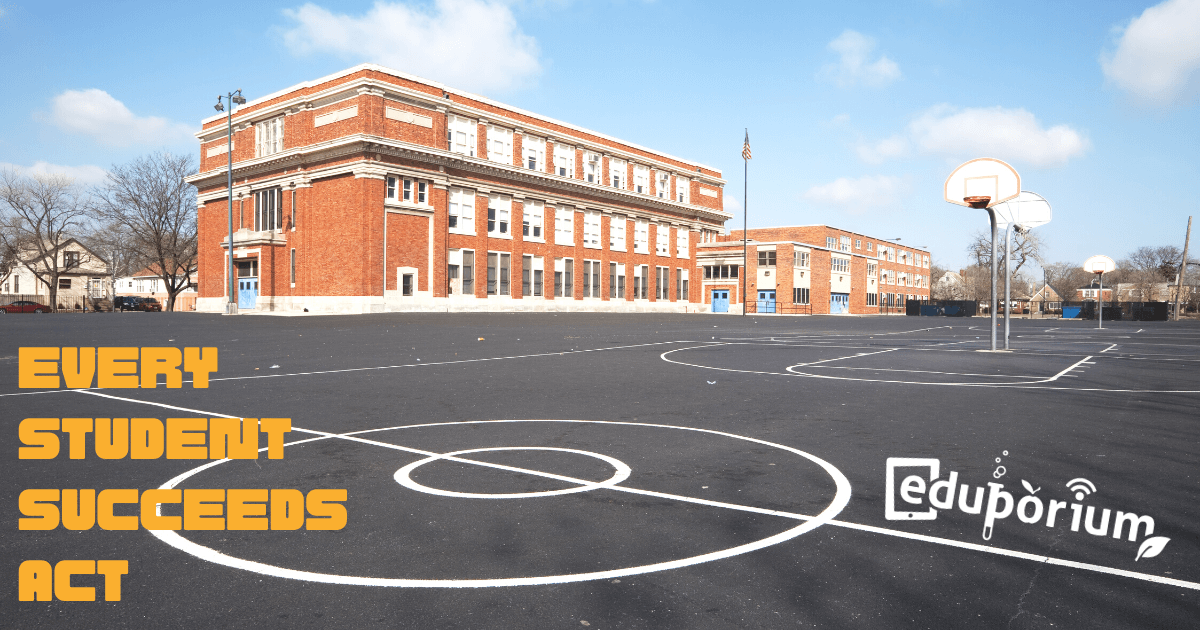Back in December, President Obama proposed and helped pass the Every Student Succeeds Act. A more modern version of No Child Left Behind, the ESSA will aim to ensure that every K-12 student in the United States has access to all the latest and greatest in educational technology every day. With around $4B now committed to provide access to STEM, teachers and administrators can revitalize all classrooms very soon.
What is the ESSA? An Overview
You may have heard there is an election coming up in a few months. You also may have heard the phrase “strengthening the middle class” or some variation of that a few dozen times over just the last few weeks. Doing just that—strengthening the middle class—is something that is rooted deeply in providing students with a stronger educational experience from the first minute they enter their first school as a five-year-old. With the adoption of the ESSA, school leaders will soon be held to higher academic standards as they all aim to prepare students to fill the vast vacancy of STEM vocations available in our nation’s economy.
The ESSA is designed to both hold educators to higher standards and better prepare kids for their futures. This piece of legislation will, in theory, transform learning from lectures into hands-on adventures that hold kids’ attention more effectively. By adding an interactive dimension to education, educators can empower their students to become makers, movers, and problem solvers while demonstrating creativity throughout a series of project-based challenges. What they are doing is taking tons of evidence from actual scenarios and shifting to teaching the whole child.
The major goal with the ESSA is to provide every child with the opportunities, previously hindered by costs and access in general, to become prepared for living in the 21st century. By providing educators with some of the necessary funds, President Obama’s plan could help cut the Digital Divide in half. Also, if all goes as planned, it should make college more affordable and transform pen-and-paper education into a hands-on adventures. Not to forget teachers, the ESSA also includes money for training and hiring at least 100,000 new STEM teachers. Many educators will be capable of doing things they were never able to do before.
An Equal Opportunity For All
If we had to pick just one word to describe the Every Student Succeeds Act, that one word is ‘equity.’ No longer will kids be penalized for coming from economically insecure families or attend a less economically secure district. The ESSA aims to erase the problematic trend of children falling behind all their peers just because they lack some funds and resources to acquire the most up-to-date learning tools. By providing this extremely welcomed opportunity for innovation, it will help educators improve these students’ lives.
Some experts predict that kids may be looking at 10-15 different careers while they’re part of this working world. Since we know that many of them may hold jobs that do not yet exist, this estimate remains entirely possible. Educators and parents know that learning with technology gives kids the chance to develop their creativity and work collaboratively. Essentially the ESSA provides kids an early starting point in building the skills they'll most likely need in the future. Technology helps bring this learning alive by coupling interactive activities with project-based opportunities—exactly the kind of work that's expected to fully dominate our economy over the next few decades. In an era in which continuous improvement is key, learning how kids learn is crucial and centers on hands-on adventures.
Knowledge is certainly a valuable trait but, in the future, adaptability, creativity, and innovation may surpass it. Learning happens in real time so quality education must support that learning. The federal government's investment in providing the funding could also lead to an increased investment in EdTech on their end. We aren't talking about giving all kids a laptop and leaving them on their own the whole school year. Educators must plan their ESSA spending wisely and then compile varying technologies that help kids learn by doing. From their first day of school to the last, there's a STEM tool that can help kids see concepts more clearly, engage in learning more willingly, and spur their overall growth more effectively—and it's all thanks to the funding made available by the ESSA.

The Future of Computer Science and STEM
Our government, perhaps very fortunately, has realized that the importance of STEM education is now too high to overlook. Not only has the government allocated billions of dollars to help prepare today’s students for tomorrow, they have even spelled out how schools should go about accomplishing that. The context of the ESSA calls for monumental shifts in what we teach in classrooms and how we teach it. It even goes as far as requiring computer science classes as core academic subjects—just like English, History, and Math. Making the school day as much like a real-world job as possible will only benefit the students involved.
The language in the ESSA defines a well-rounded education as one that includes Computer Science along with other traditional subjects. This is so important because, as we know, much of education funding goes into developing the traditional school subjects like Writing, Reading, and Science, but, now that Computer Science is to become a regular part of the school day, more money should go to creating stronger in-class programs. The government has made it possible for state leaders to ensure that every child in their school systems has the chance to learn computer science and, thus, a much greater likelihood of future success.
The passing of the ESSA may completely revamp our nation’s school systems and truly open up computer science for all. It calls for strengthening school infrastructure, addressing digital equity, and building STEM-minded school leaders so that students may benefit. As district leaders begin implementing new computer science initiatives into their respective curricula, millions of children will soon have access to learning tools and innovative environments that they have never had before and would not likely ever have if not for these changes. Our world runs on computers and billions of scientific systems that require constant maintenance and upgrades. The ESSA will help teachers develop students into people who know them inside and out.
The ESSA And Academic Opportunities
One of the more popular features of the ESSA, at least thus far, appears to be the fact that district leaders will get to use federal dollars to improve instruction and they'll face less federal control in the process. The ESSA calls for the federal government to have a significantly smaller role in education and state leaders to innovate and educate how they see fit, a solid step in eliminating the one-size-fits-all models that we used heavily for quite some time. Under the ESSA, state officials can fully implement policies or procedures that encourage excellence and promote personalization in their students. Each state will be different, but every student in the country now has a greater opportunity to succeed.
Much of the emphasis in 21st century education focuses on encouraging our teachers to practice student choice in learning. The ESSA will now support leaders in underperforming schools or districts, particularly, with improving their efforts in various ways. First, there will be expanded enrollments in the supplementary courses as well as expanded participation in a slew of CTE courses with new hope that it leads to industry certifications among other areas of growth. Perhaps the more significant development, however, is a plan to magnify personalization in education. The ESSA will give school leaders new chances to give students options in the classroom and afterschool through tutoring programs.
To set school leaders up even better, the ESSA will also provide academic enrichment grants in support of innovation priorities. To ensure proper use of this money, however, district leaders must spend it on one of three things: well-rounded educational opportunities, shaping safe and healthy children, or on the effective use of technology. At least 20 percent of this must be for well-rounded education opportunities, including access to and success in well-rounded experiences, like supplemental course offerings that boost student achievements. The safe and happy students section includes programs for promoting active learning and a drug-free culture. This also must account for at least 20 percent of the allocation. As for the effective use of technology, teachers and administrators will receive resources to help personalize learning, but this cannot include more than 15 percent of the funding, illustrating the ESSA’s purpose as a cooperative accord.

Using the ESSA to Drive Innovation in Schools
Though the ESSA has been a breath of fresh air, we think it’s done more than that once being signed. If you ask us, teachers seem legitimately excited and are taking it upon themselves to start innovating right away! Perhaps more importantly, the ESSA seems poised to help children succeed simply because they will have more freedom to learn. Teachers and students will soon be able to reap various benefits of the ESSA when it comes to flipped learning, blended learning, and additional technology innovations in PBL.
Many feel that, with help from the ESSA, blended learning could move from an occasional experiment into many routine approaches. There are provisions within this legislation for providing funding for creating and implementing exactly these types of programs. Since the ESSA provides state officials more control of the curriculum, innovative school could start popping up in more places. And, hey, as long as the teachers buy in and undergo the proper training, there’s absolutely nothing wrong with that! The ESSA will help students set the pace for their own learning and create a new kind of education system. And, we also believe that it will appeal to both children and teachers simply due to its flexibility.
Every school system tends to have its own set of unique goals for children to achieve. In theory, this seems like a great foundation since every child has different interests, different personalities, and learns differently. Hopefully, the ESSA will empower many more teachers to truly personalize learning for every student in the school. To ensure that the opportunities afforded by the ESSA are activated and enjoyed, educators can try to create a culture that’s optimistic about implementing innovation and hire the right teachers. In the end, it is more about the outcome than the planning and process. If you're already feeling the effects of the ESSA, let us know—we’d love learning how it’s helping your instruction.
For the latest EdTech, STEM, and 21st century education news, follow us on Twitter and Instagram. Like us on Facebook, too, or sign up for our newsletter for our latest product announcements and offerings. If you have an idea for an Eduporium Weekly theme, send us a message on social media or comment below.



